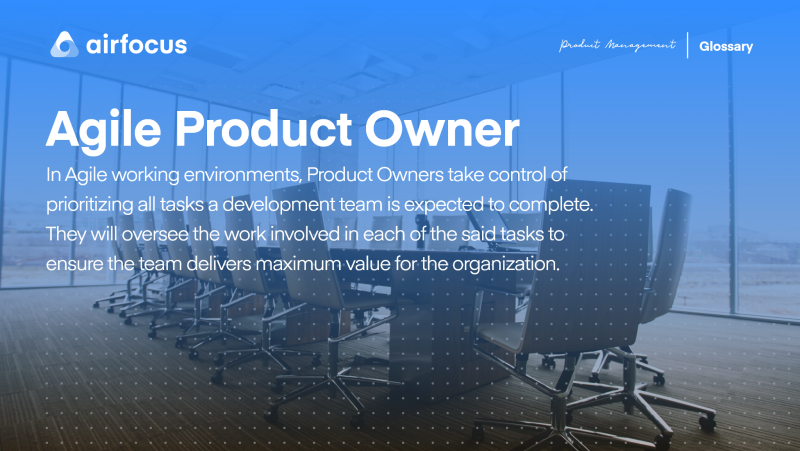Agile Product Owner
What is an agile product owner?
Definition of an Agile product owner
In Agile working environments, product owners take control of prioritizing all tasks a development team is expected to complete. They will oversee the work involved in each of the said tasks to ensure the team delivers maximum value for the organization.
This is a critical role in the development of any software product in agile workplaces. Essentially, a product owner functions as the project management lead, interacting with both product management and development teams closely. They guide a product’s progress to completion and drive developers to deliver the results expected.
All plans and goals passed on to product owners from the product management team will be worked into a coherent strategy suitable for the development team (involving smaller tasks and stories). This will be part of the product backlog, the list of prioritized features essential to a product’s development.
While product owners might belong to the overall product management team, they are typically considered a part of the development team in the majority of cases.
What are the key responsibilities of an agile product owner?
Agile product owners have a challenging role in the development of a product, with a variety of responsibilities to consider. These include:
Identifying the overall goal of a product
An agile product owner has to take what may be a complex product strategy and translate that into a plan the development team is capable of handling successfully. Before they can do this, they must establish a clear understanding of what the organization wants to achieve with the product and the strategy in place.
This may involve researching user personas to identify the core audience for the product and the issues it’s intended to resolve. Once a product owner feels comfortable with the necessity for the product to hit the market in the first place, they can guide the development team to make the vision a reality.
Put a plan in place effectively
Agile product owners are also responsible for prioritizing developers’ tasks — and that’s no mean feat. Why? Because it involves understanding the resources and money available to the team, the time they have to work with before the product’s expected completion date, and the product roadmap itself.
Product backlog management
Agile product owners take responsibility for the management of product backlogs. The agile methodology breaks development down into manageable sprints, and the product backlog contains prioritized tasks that should be completed within sprints. Product owners must make sure all necessary tasks are added before a sprint begins.
They must also define stories — brief descriptions of functionality the development team is required to create.
Maintain communication between product management and development teams
Last but by no means least, agile product owners are responsible for maintaining communication between product management and development teams.
Both teams need to be aware of the other’s requirements, challenges, limitations, resources, and other relevant details. This helps both teams follow a product’s progress in an honest, accurate way, minimizing the risk of oversights or mistakes arising from poor communication.
What are the benefits of using agile methods as a product owner?
For product owners, the benefits of embracing the agile methodology include:
Achieving a higher standard of product
Agile’s iterative nature places great importance on continual testing to identify necessary changes, address issues, and adapting the product to ensure it aligns with the needs of users and the market. This leads to higher product quality in the long run.
Enjoy tighter control over product development
Product owners in agile workplaces can expect tighter control over a product’s development, right up to its release. Again, this comes down to comprehensive testing on a frequent basis and integrating feedback into the ongoing development.
Progress reports delivered on a daily basis allow stakeholders to stay updated on the product’s status, to alleviate any concerns they may have.
Decreased danger of product failure
Using agile methods empowers product owners to help development teams complete goals on time through the sprint structure. Breaking bigger goals down into smaller tasks narrows the team’s focus and facilitates a cycle of consistent delivery. Completion occurs in a fixed process rather than “as and when”.
Any issues encountered during one sprint can be analyzed and refined ahead of the next. This means obstacles that affect productivity, efficiency, or quality can be avoided or even eliminated.
Is agile right for your product team?
Agile may not always be the ideal option for every product team.
Generally, agile is considered the right approach when a product’s requirements may be uncertain. The agile methodology enables product owners to work on user stories and build a product backlog to clarify these requirements more efficiently.
This is less risky than simply throwing a development team in at the deep end without them really understanding what they’re expected to achieve.
This is where sprints prove beneficial, too. Product owners, stakeholders, and developers can all assess progress achieved during each sprint to understand successes or failures. Is the product’s current version close to what it should be? Were the features built during that sprint as valuable as expected, or should they be reconsidered?
Agile also works well when companies want to encourage employees to learn from failure when speed is a priority, and managers want to foster greater collaboration among teams.

General FAQ

Glossary categories
Experience the new way of doing product management

Experience the new way of doing product management







